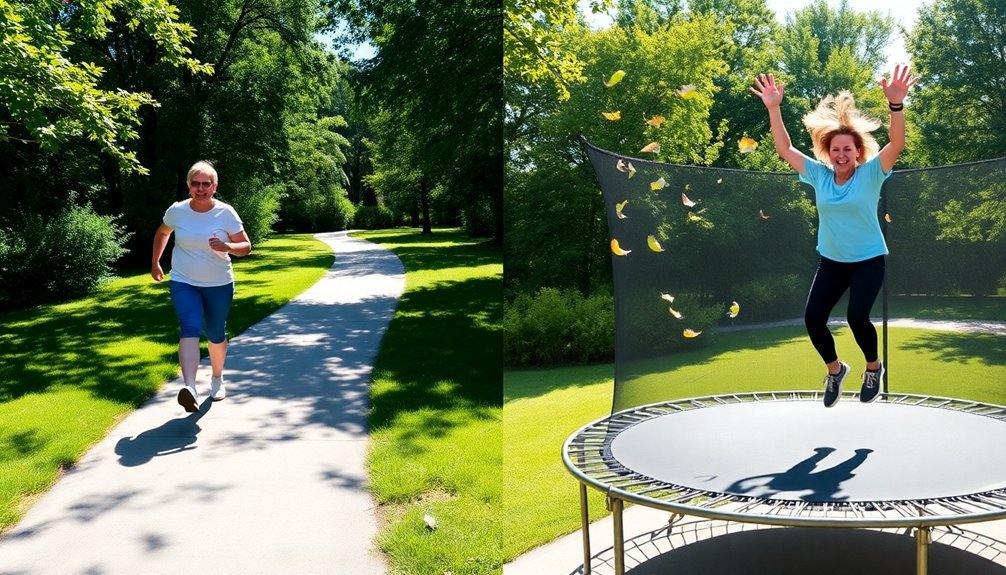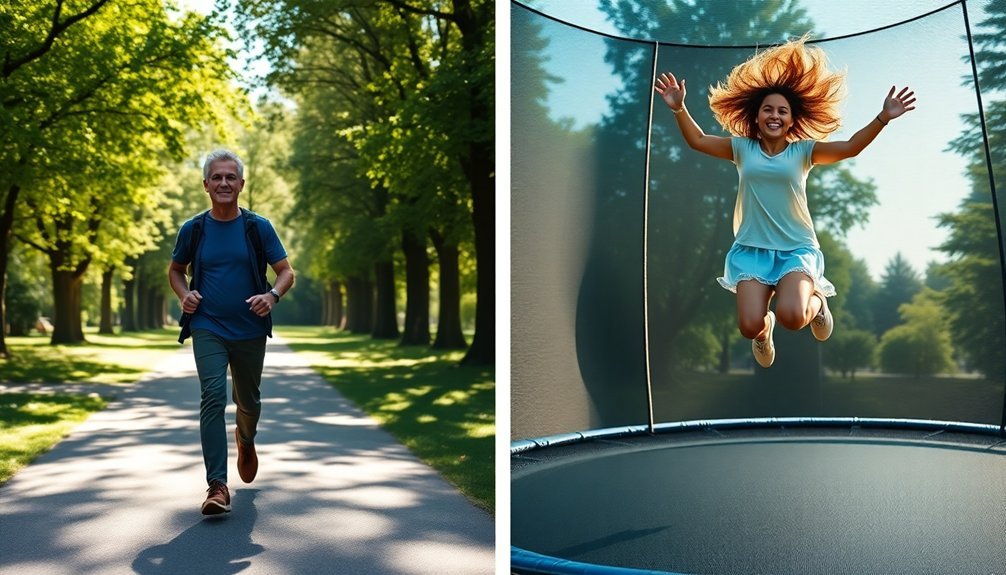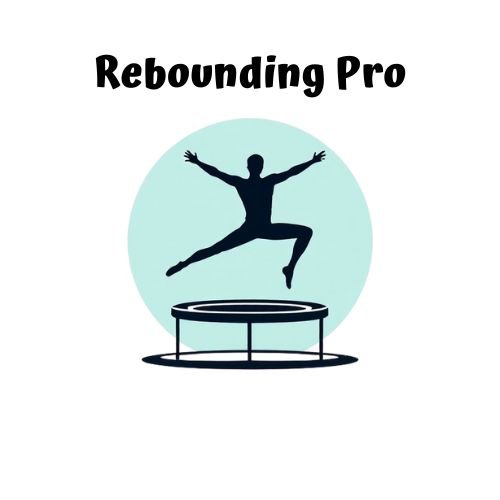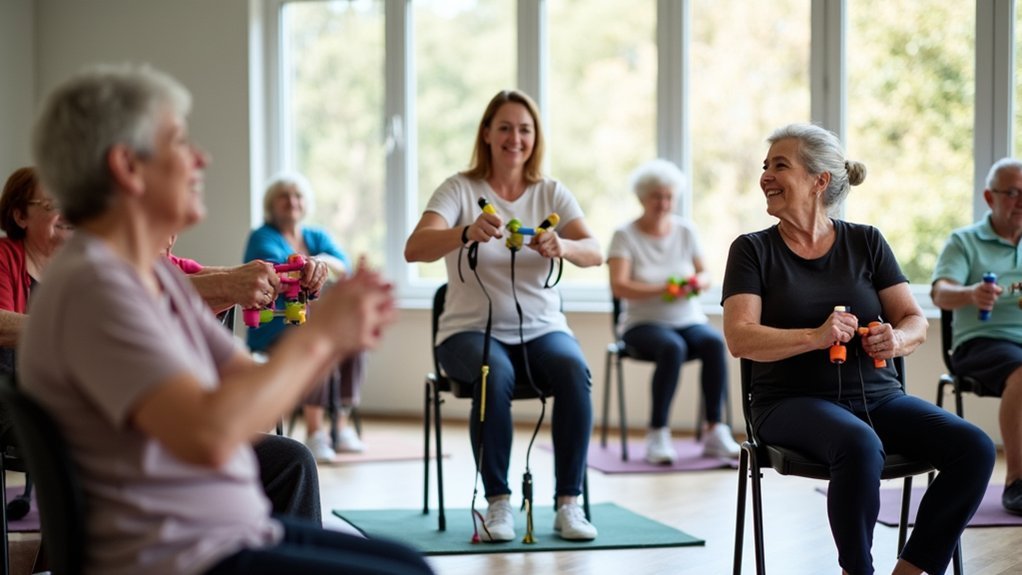For ideal lymphatic drainage, both walking and trampolining offer excellent benefits. Walking uses muscle contractions to push lymph fluid, while trampolining's bouncing motion creates alternating g-forces that efficiently open and close lymphatic valves. You'll get better results with 10-15 minutes of trampolining or longer, brisk walking sessions. Consider combining both exercises for maximum effect. Wearing compression garments can enhance benefits, especially if you have lymphedema. Discover five more powerful lymphatic-boosting activities below.
How the Lymphatic System Responds to Different Exercises

Unlike the circulatory system which has the heart as its central pump, your lymphatic system relies entirely on body movement to function effectively. Without regular physical activity, lymph fluid stagnates, hampering toxin removal and immune function.
Different exercises impact lymphatic flow in various ways. Rhythmic movements like walking provide steady stimulation, while trampolining's up-and-down motion can increase lymph flow up to 15 times normal rates. Vertical exercises like rebounding and dancing are particularly effective as they can increase lymph flow by 15-30 times compared to sedentary states.
Not all exercise is created equal for your lymphatic system—rebounding on a trampoline can boost lymph flow 15x more than simply walking.
Deep breathing exercises activate central lymphatics through diaphragmatic movement, and shoulder rolls help drain lymph from your head and neck regions.
The intensity matters too—moderate activity for 10-15 minutes is often sufficient for promoting drainage. Structured routines with varied movements generally yield better results than repetitive actions alone, especially when performed 3-5 times weekly with proper warm-up.
The Science Behind Walking for Lymphatic Flow
Walking represents one of the most effective and accessible exercises for lymphatic health, backed by solid scientific principles. Unlike your circulatory system, your lymphatic system lacks a central pump, relying instead on muscle contractions and breathing to move fluid. When you walk, the rhythmic contractions of your leg muscles create a pumping action that propels lymph upward against gravity. The three key muscles – transverse abdominis, pelvic floor, and diaphragm – work together during walking to optimize lymphatic drainage.
| Mechanism | How Walking Helps | Benefit |
|---|---|---|
| Muscle Pump | Leg contractions push lymph through vessels | Enhances toxin removal |
| Diaphragmatic Movement | Breathing creates pressure changes | Improves central drainage |
| Gravitational Forces | Upright posture assists fluid return | Prevents fluid stagnation |
This natural, low-impact activity engages multiple muscle groups while reducing stress—a dual benefit that supports overall immune function and longevity.
Rebounding Benefits: Why Trampolines Stimulate Lymph Circulation

Rebounding on a mini-trampoline may revolutionize your approach to lymphatic health. The unique up-and-down motion creates a powerful pumping effect that traditional exercises can't match. As you bounce, alternating g-forces open and close lymphatic valves, enhancing fluid movement throughout your body. Prolonged sitting at desk jobs can significantly impede healthy lymphatic circulation, making regular rebounding sessions particularly valuable for office workers.
Bounce your way to better lymphatic health with a mini-trampoline's unique g-force action that traditional exercise simply can't deliver.
Unlike high-impact activities, rebounding offers considerable benefits without stressing your joints:
- Enhanced detoxification – The rhythmic bouncing accelerates toxin removal from tissues
- Immune system support – Improved lymph circulation helps distribute immune cells more effectively
- Reduced swelling – Regular 10-20 minute sessions can decrease fluid retention in legs and ankles
You don't need elaborate equipment or extensive time commitment – even gentle bouncing for short periods can considerably improve your lymphatic flow and overall health.
Comparing Impact: Walking vs. Trampolining on Joint Health
When it comes to protecting your joints while exercising, understanding the impact differences between walking and trampolining can make all the difference in your lymphatic health journey.
Trampolining surprisingly absorbs up to 80% of impact forces, making it gentler on your joints than you might expect. While walking places minimal stress on joints, the rebounding surface of a trampoline provides additional cushioning that reduces strain.
Both activities are considered low-impact, but they differ in risk profiles. Walking carries lower injury risk overall, while trampolining requires proper technique to avoid sprains or strains. This is particularly important if you have existing joint concerns.
Studies show nearly 50% of runners experience joint pain, whereas proper trampolining typically results in minimal discomfort. Trampolining engages every muscle group without placing harsh impact on the joints, making it an excellent option for comprehensive fitness.
Optimal Duration and Intensity for Lymphatic Drainage Exercises

Knowing which exercises benefit your lymphatic system is valuable, but understanding exactly how long and how intensely to perform them determines your results.
For effective lymphatic stimulation, trampolining works best in shorter 10-15 minute sessions that can be distributed throughout your day, while walking benefits from longer durations at a brisk pace.
The intensity level considerably impacts effectiveness:
- Gentle, consistent bouncing on a trampoline stimulates lymph flow better than vigorous jumping
- Rhythmic movements engage large muscle groups, enhancing toxin removal
- Gradual intensity progression often yields better results than starting too aggressively
Remember that consistency trumps occasional intense sessions.
Daily practice of either exercise—even for brief periods—provides more substantial lymphatic benefits than sporadic longer workouts, especially for those managing conditions like lymphedema. For those over 50, rebounding offers low-impact exercise that supports bone density while promoting lymphatic circulation.
Combining Trampolining and Walking for Maximum Benefits
Combining two complementary exercises creates a powerful strategy for ideal lymphatic health. When you alternate between trampolining's bouncing motion and walking's rhythmic strides, you're engaging different muscle groups that enhance lymphatic circulation. This variety keeps your fitness routine interesting while ensuring consistent benefits for your immune system. Jumping on a trampoline for just 10 minutes can significantly increase lymph flow rates compared to sedentary activities.
| Benefit | Trampolining | Walking |
|---|---|---|
| Impact Level | Low-impact bouncing | Moderate ground contact |
| Muscle Focus | Full-body activation | Lower body emphasis |
| Lymph Stimulation | Vertical compression | Rhythmic pumping action |
You'll maximize results by starting with basic movements and gradually increasing intensity as your fitness improves. Try alternating days between these activities or combining them in a single session. This balanced approach reduces inflammation, improves detoxification, and enhances your body's natural waste removal system.
Safety Tips and Modifications for Effective Lymphatic Exercise
Safety considerations should accompany any lymphatic exercise routine, especially after exploring combination approaches like trampolining and walking.
Safety first—lymphatic exercise requires caution, particularly when combining activities like trampolining with walking.
Always consult healthcare professionals before starting, particularly if you're managing lymphedema or recovering from surgery. Monitor your body's responses and stop immediately if you experience pain or discomfort.
For ideal safety and effectiveness, consider these modifications:
- Wear compression garments during exercise to prevent fluid buildup and manage lymphedema symptoms.
- Choose soft surfaces like grass for walking to reduce joint impact and protect your lymphatic system.
- Incorporate diaphragmatic breathing techniques to enhance lymphatic flow while exercising.
- Gradually increase your exercise duration and intensity to avoid overloading the lymphatic system.
If you have specific health conditions, adjust accordingly—avoid exercising during fevers or infections, and skip high-impact activities without medical clearance after surgery.
Remember that low-impact exercises still provide significant circulation and strength benefits.
Frequently Asked Questions
Can Lymphatic Drainage Exercises Help With Post-Surgery Recovery?
Yes, lymphatic drainage exercises can greatly aid your post-surgery recovery by reducing swelling, minimizing scar tissue formation, accelerating healing, and decreasing infection risk. Always consult your healthcare provider before starting these exercises.
Are There Age Restrictions for Trampolining as Lymphatic Drainage?
No strict age restrictions exist for trampolining as lymphatic drainage. You can benefit at any age, but should consult your doctor if you're elderly or have health concerns. Use stability bars for extra safety.
How Soon Can Results Be Noticed From Regular Drainage Exercises?
You'll notice improvements within a few sessions of regular lymphatic drainage exercises. Visible benefits like reduced swelling and better skin tone can appear quickly, while energy boosts and immune benefits develop with consistent practice.
Should Lymphatic Exercises Be Done Before or After Meals?
You can do lymphatic exercises either before or after meals. While post-meal activities may aid digestion, pre-meal exercises improve circulation. The key is consistency rather than timing – just stay well-hydrated whenever you exercise.
Can Specific Clothing Enhance the Benefits of Lymphatic Drainage Exercises?
Yes, gradient compression garments can enhance your lymphatic drainage by improving circulation while exercising. You'll benefit most from breathable, non-restrictive clothing that supports fluid movement without impeding your natural lymphatic flow.
In Summary
You've now got the tools to boost your lymphatic health through movement. Whether you're taking daily walks or bouncing on a trampoline, consistency is key. Remember that both exercises offer unique benefits—walking provides gentle, accessible stimulation while trampolining delivers more intensive drainage. For ideal results, combine both activities and listen to your body, adjusting intensity as needed. Your lymphatic system will thank you!





Leave a Reply